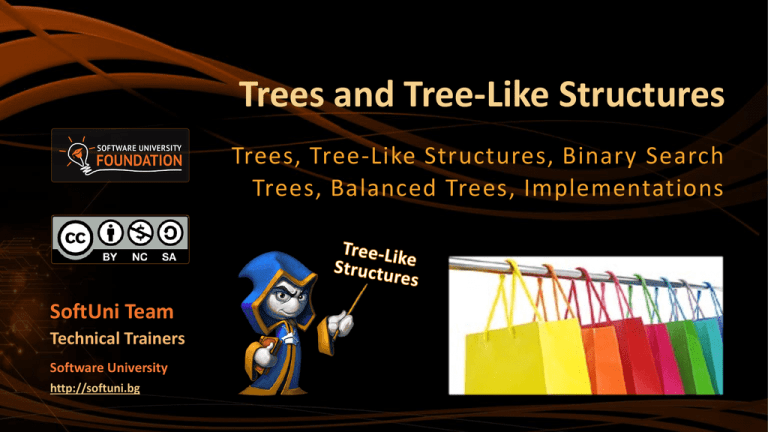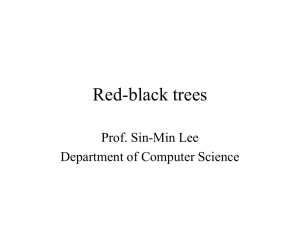Trees and Tree-Like Structures
advertisement

Trees and Tree-Like Structures
Trees, Tree-Like Structures, Binary Search
Trees, Balanced Trees, Implementations
SoftUni Team
Technical Trainers
Software University
http://softuni.bg
Table of Contents
1. Tree-like Data Structures
2. Trees and Related Terminology
3. Implementing Trees
4. Binary Trees and Traversals
Pre-order (node, left, right)
In-order (left, node, right)
Post-order (left, right, node)
5. Balanced Search Trees
6. Graphs
2
1
7
14
21
19
31
Tree-like Data Structures
Trees, Balanced Trees, Graphs, Networks
Tree-like Data Structures
Tree-like data structures are:
Branched recursive data structures
Consisting of nodes
Each node connected to other nodes
Examples of tree-like structures
Trees: binary, balanced, ordered, etc.
Graphs: directed / undirected, weighted, etc.
Networks: graphs with multiple relations between nodes
4
Tree-like Data Structures
2
1
Network
Tree
Project
Manager
Team Leader
Developer 1
Designer
Developer 3
6
3
QA Team
Leader
Tester 1
4
5
Tester 2
7
1
Developer 2
14
4
Graph
21
11
12
19
31
5
Project
Manager
Team
Leader
Designer
QA Team
Leader
Trees and Related Terminology
Node, Edge, Root, Children, Parent, Leaf,
Binary Search Tree, Balanced Tree
Tree Data Structure – Terminology
Node, edge, root, child, children, siblings, parent, ancestor,
descendant, predecessor, successor, internal node, leaf, depth,
height, subtree
Depth 0
17
Height = 3
14
9
6
5
15
8
Depth 1
Depth 2
7
Implementing Trees
Recursive Tree Data Structure
Recursive Tree Definition
The recursive definition for tree data structure:
A single node is tree
Tree nodes can have zero or multiple children that are also trees
Tree node definition in C#
The value stored
in the node
public class Tree<T>
{
private T value;
private IList<Tree<T>> children;
…
List of child nodes, which
}
are of the same type
9
Tree<int> Structure – Example
IList<Tree<int>> children
int value
19
1
children
children
12
31
7
children
21
children
children
Tree<int>
14
23
children
children
6
children
children
10
Implementing Tree<T>
public class Tree<T>
{
public T Value { get; set; }
public IList<Tree<T>> Children { get; private set; }
public Tree(T value, params Tree<T>[] children)
{
Flexible constructor
this.Value = value;
for building trees
this.Children = new List<Tree<T>>();
foreach (var child in children)
{
this.Children.Add(child);
}
}
}
11
Building a Tree
Constructing a tree by nested constructors:
Tree<int> tree =
new Tree<int>(7,
new Tree<int>(19,
new Tree<int>(1),
new Tree<int>(12),
new Tree<int>(31)),
new Tree<int>(21),
new Tree<int>(14,
new Tree<int>(23),
new Tree<int>(6))
);
7
19
1
12
21
31
14
23
6
12
Printing a Tree
Printing a tree at the console – recursive algorithm
public class Tree<T>
{
…
public void Print(int indent = 0)
{
Console.Write(new string(' ', 2 * indent));
Console.WriteLine(this.Value);
foreach (var child in this.Children)
child.Print(indent + 1);
}
}
13
Lab Exercise
Trees and Trees Traversal
Binary Trees and Traversals
Preorder, In-Order, Post-Order
Binary Trees
Binary trees: the most widespread form
Each node has at most 2 children (left and right)
Root node
Right child
17
Left
subtree
9
6
15
5
8
Right child
10
Left child
16
Binary Trees Traversal
Binary trees can be traversed in 3 ways:
*
Pre-order: root, left, right
+
In-order: left, root, child
Post-order: left, right, root
3
-
2
9
6
Example:
Arithmetic expression stored
as binary tree: (3 + 2) * (9 - 6)
Pre-order: * + 3 2 - 9 6
In-order: 3 + 2 * 9 - 6
Post-order: 3 2 + 9 6 - *
Lab Exercise
Binary Trees and Traversal
Binary Search Trees
Binary search trees are ordered
For each node x in the tree
All the elements in the left subtree of x are ≤ x
All the elements in the right subtree of x are > x
Binary search trees can be balanced
Balanced trees have for each node
Nearly equal number of nodes in its subtrees
Balanced trees have height of ~ log(x)
19
Binary Search Trees (2)
Example of balanced binary search tree
17
9
6
19
12
25
If the tree is balanced, add / search / delete operations take
approximately log(n) steps
20
Balanced Search Trees
AVL Trees, B-Trees, Red-Black Trees, AA-Trees
Balanced Binary Search Trees
Ordered Binary Trees (Binary Search Trees)
For each node x the left subtree has values ≤ x and the right
subtree has values > x
Balanced Trees
For each node its subtrees contain nearly equal number of nodes
nearly the same height
Balanced Binary Search Trees
Ordered binary search trees that have height of log2(n) where n is
the number of their nodes
Searching costs about log2(n) comparisons
22
Balanced Binary Search Tree – Example
The left
subtree has
7 nodes
33
The right
subtree has
7 nodes
18
54
15
3
24
17
20
42
29
37
60
43
85
23
Balanced Binary Search Trees
Balanced binary search trees are hard to implement
Rebalancing the tree after insert / delete is complex
Rotations change the structure without interfering the nodes order
Well known implementations of balanced binary search trees
AVL Trees – ideally balanced, very complex
Red-black Trees – roughly balanced, more simple
AA-Trees – relatively simple to implement
Find / insert / delete operations need log(n) steps
24
AVL Tree – Example
AVL tree (Adelson-Velskii and Landis)
Self-balancing binary-search tree (see the visualization)
25
Red-Black Tree – Example
Red-Black tree – binary search tree with red and black nodes
Not perfectly balanced, but has height of O(log(n))
Used in C# and Java
See the visualization
AVL vs. Red-Black
AVL has faster search
(it is better balanced)
Red-Black has faster
insert / delete
26
AA Tree – Example
AA tree (Arne Andersson)
Simple self-balancing binary-search tree
Simplified Red-Black tree
Easier to implement
than AVL and Red-Black
Some Red-Black
rotations are
not needed
27
B-Trees
B-trees are generalization of the concept of ordered binary
search trees – see the visualization
B-tree of order b has between b and 2*b keys in a node and
between b+1 and 2*b+1 child nodes
The keys in each node are ordered increasingly
All keys in a child node have values between their left and right
parent keys
If the B-tree is balanced, its search / insert / add operations take
about log(n) steps
B-trees can be efficiently stored on the disk
28
B-Tree – Example
B-Tree of order 2 (also known as 2-3-4-tree):
7
4
5
6
8
9
11
12
16
17
21
18
20
22
26
23
25
31
27
29
30
32
35
29
Balanced Search Trees
AVL Trees, B-Trees, Red-Black Trees, AA-Trees
Balanced Trees in .NET
.NET Framework has several built-in implementations of
balanced search trees:
SortedDictionary<K, V>
Red-black tree based dictionary (map) of key-value pairs
SortedSet<T>
Red-black tree based set of elements
External libraries like "Wintellect Power Collections for .NET" are
more flexible
http://powercollections.codeplex.com
31
OrderedSet<T>: Red-Black Tree in .NET
In .NET Framework OrderedSet<T> is based on red-black tree
Holds an ordered set of non-repeating elements
Insert / delete / find / subset has O(log(n)) running time
var set = new SortedSet<int>();
set.Add(5); // 5
set.Add(8); // 5, 8
set.Add(-2); // -2, 5, 8
set.Add(30); // -2, 5, 8, 30
set.Add(20); // -2, 5, 8, 20, 30
var subset = set.GetViewBetween(5, 20);
subset.ToList().ForEach(Console.WriteLine); // 5, 8, 20
32
7
1
14
4
21
11
12
19
31
Graphs
Set of Nodes Connected with Edges
Graph Data Structure
Graph (denoted as G(V, E))
Set of nodes V with many-to-many relationship between them (edges E)
Each node (vertex) has multiple predecessors and multiple successors
Edges connect two nodes (vertices)
Node with multiple
successors
Edge
Node with multiple
predecessors
7
1
14
4
21
Node
11
12
19
31
Self-relationship
34
Graph Definitions
Node (vertex)
Element of graph
Can have name or value
Node
A
Keeps a list of adjacent nodes
Edge
Edge
Connection between two nodes
Can be directed / undirected
A
B
Can be weighted / unweighted
Can have name / value
35
Graph Definitions (2)
Directed graph
Undirected graph
Edges have direction
22
Edges have no direction
2
3
A
F
J
7
1
4
D
G
21
12
3
19
E
C
H
36
Graph Definitions (3)
Weighted graph
Weight (cost) is associated with each edge:
10
A
6
Q
D
E
14
F
16
4
5
J
8
7
9
C
G
N
22
3
H
K
37
Graphs – Implementation
Typically graphs are stored as
lists of descendant nodes
Instead of nodes, usually
their index (number) is stored
Graph
new
new
new
new
new
new
new
});
public class Graph
{
List<int>[] childNodes;
public Graph(List<int>[] nodes)
{
this.childNodes = nodes;
}
}
g = new Graph(new List<int>[] {
List<int> {3, 6}, // successors of vertex 0
List<int> {2, 3, 4, 5, 6},// successors of vertex 1
List<int> {1, 4, 5}, // successors of vertex 2
List<int> {0, 1, 5}, // successors of vertex 3
List<int> {1, 2, 6}, // successors of vertex 4
List<int> {1, 2, 3}, // successors of vertex 5
List<int> {0, 1, 4} // successors of vertex 6
6
0
3
1
4
5
2
38
Summary
Trees are recursive data structures
A tree is a node holding a set of children (which are also nodes)
Binary search trees are ordered binary trees
Balanced trees have weight of log(n)
AVL trees, Red-Black trees and AA trees are self-balancing binary
search trees, used to implement ordered sets, bags and dictionaries
Graph == set of nodes with many-to-many relationships
Can be directed / undirected, weighted / unweighted, connected /
not connected, etc.
39
Trees and Tree-Like Structures
?
https://softuni.bg/trainings/1147/Data-Structures-June-2015
License
This course (slides, examples, labs, videos, homework, etc.)
is licensed under the "Creative Commons AttributionNonCommercial-ShareAlike 4.0 International" license
Attribution: this work may contain portions from
"Fundamentals of Computer Programming with C#" book by Svetlin Nakov & Co. under CC-BY-SA license
"Data Structures and Algorithms" course by Telerik Academy under CC-BY-NC-SA license
41
Free Trainings @ Software University
Software University Foundation – softuni.org
Software University – High-Quality Education,
Profession and Job for Software Developers
softuni.bg
Software University @ Facebook
facebook.com/SoftwareUniversity
Software University @ YouTube
youtube.com/SoftwareUniversity
Software University Forums – forum.softuni.bg






